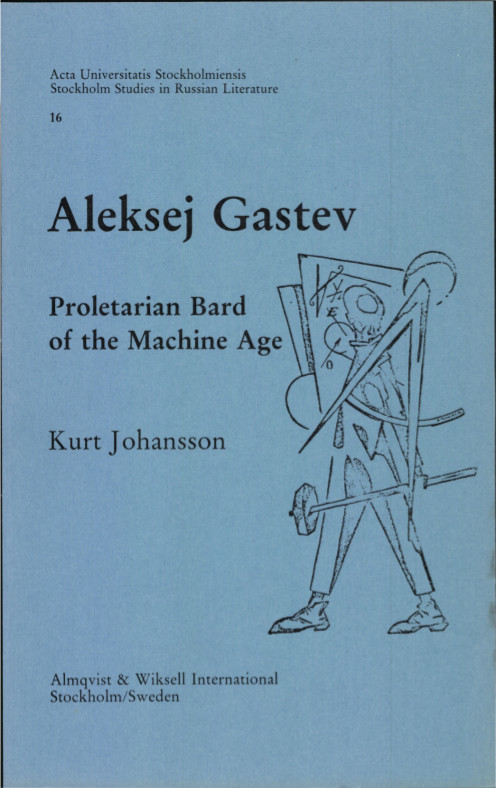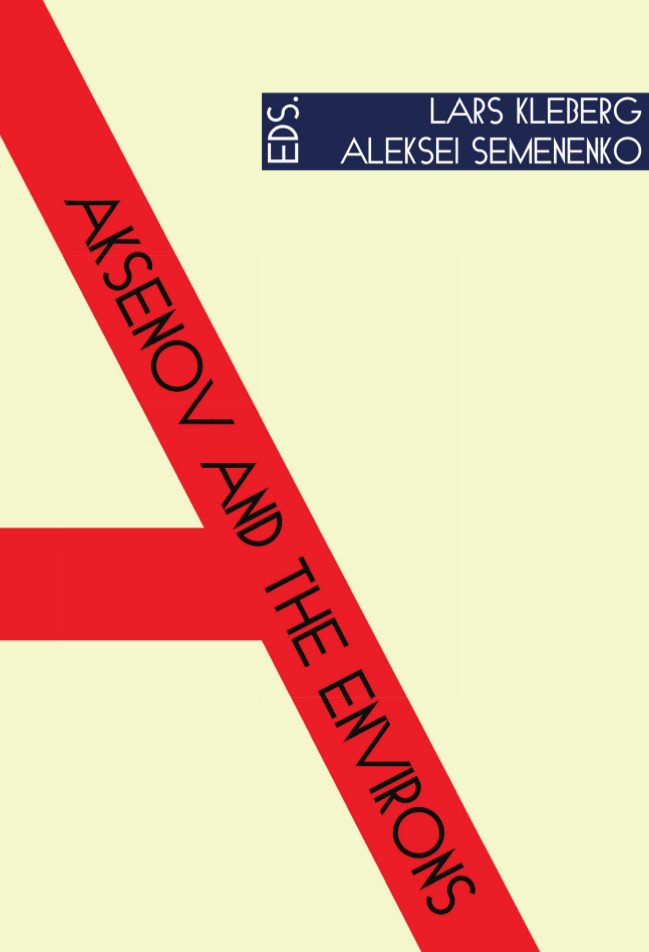Kurt Johansson: Aleksej Gastev: Proletarian Bard of the Machine Age (1983)
Filed under book | Tags: · 1910s, biography, machine, management, poetry, proletariat, russia, taylorism

This book attempts to give an outline of Aleksej Gastev’s life and works primarily up until 1920.
Aleksej Gastev (1882-1941?) belonged to the Russian proletarian intelligentsia. He was an active revolutionary, a journalist with syndicalist leanings, a metal-worker and trade-union leader, and one of the best proletarian poets. In later years he became perhaps the most important champion of the Taylor system and scientific management in Russia; as the founder and leader of the Institute of Labour (CIT) in Moscow he trained hundreds of thousands of new workers for Soviet industry. In 1938 he fell a victim to the Stalinist terror.
Besides presenting his biography, the present study tries to trace the development of Gastev’s Utopian ideas about the creation of a New Man suited to the industrial society of the future. In his articles and poems the worker is so Intimately fused with machines that he adopts their rhythm and functional movements, himself becoming “mechanical”. One chapter is specially devoted to Gastev’s poetry, the collection Poézija rabočego udara (“The Poetry of the Factory Floor”). Four prose poems are analyzed in detail. These describe the future development of the proletariat, and also show how Gastev ‘s manner of writing gradually becomes a kind of “Taylorized” poetry, that has been strongly influenced by futurism.
Publisher Almqvist & Wiksell International, Stockholm, 1983
Stockholm Studies in Russian Literature series
ISBN 9122006141
170 pages
PDF (updated on 2013-12-8)
Comment (0)Lars Kleberg, Aleksei Semenko (eds.): Aksenov and the Environs (2012) [Russian, English]
Filed under book | Tags: · art, art history, avant-garde, constructivism, futurism, literature, russia, theatre

“Ivan Aleksandrovich Aksenov (1883-1935), critic, poet, and translator, was an outstanding representative of the Russian avant-garde art.
In the 1920s, Aksenov was close to the constructivists and worked in the theatre of Vsevolod Meyerhold, also serving as the dean of its directors’ school. Aksenov’s analysis of the problems of mis-en-scène, more geometrical than ideological, influenced a new generation of directors, headed by Sergei Eisenstein.
For different reasons, Ivan Aksenov’s life and works have remained unknown outside a small circle of initiated readers. During the Soviet era, he was soon marginalized because of his engineer’s view of art and his anti-ideological position. Later, specialised scholars ignored him, finding it too difficult to grasp his versatile personality, which was both original and representative of the multi-faceted Russian avant-garde movement.
This book of essays by authors from nine different countries sheds light on the writer’s extraordinary contribution to Russian culture.”
Contributions by Lars Kleberg, John Bowlt, Nicoletta Misler, and Janne Risum are in English.
Publisher Södertörns högskola, Huddinge, 2012
Södertörn Academic Studies 52
ISBN 9186069543, 9789186069544
242 pages
via DiVA Academic Archive
Andrey Smirnov: Sound in Z: Experiments in Sound and Electronic Music in Early 20th-century Russia (2013)
Filed under book | Tags: · 1910s, 1920s, 1930s, art, art history, avant-garde, bio-mechanics, electroacoustic music, electronic music, music, music history, musical instruments, russia, sound, sound art, soviet union, technology

“Sound in Z supplies the astounding and long-lost chapter in the early story of electronic music: the Soviet experiment, a chapter that runs from 1917 to the late 1930s. Its heroes are Arseny Avraamov, inventor of Graphic Sound (drawing directly onto magnetic tape) and a 48-note scale; Alexei Gastev, who coined the term “bio-mechanics”; Leon Theremin, inventor of the world’s first electronic instrument, the Theremin; and others whose dreams for electronic sound were cut short by Stalin’s regime. Drawing on materials from numerous Moscow archives, this book reconstructs Avraamov’s Symphony of Sirens, an open-air performance for factory whistles, foghorns and artillery fire first staged in 1922, explores Graphic Sound and recounts Theremin’s extraordinary career-compiling the first full account of Russian electronic music.”
Edited by Matt Price and David Rogerson
Foreword by Jeremy Deller
Publisher Koenig Books, London, in partnership with Sound and Music, London, 2013
ISBN 3865607063, 9783865607065
281 pages
Talk by the author (audio, 90 min, 2012)
Interview with author: Nathan Budzinski (video, The Wire, 2013).
Exh. review: Daniele Balit (The Wire, 2009).
Reviews: Agata Pyzik (Calvert Journal, 2013), Colin McSwiggen (n+1, 2013), Alessandro Ludovico (Neural, 2013), Jacob Gotlib (Computer Music Journal, 2014), Thomas Patteson (Current Musicology, 2017).
PDF, PDF (14 MB, updated on 2020-11-1)
Comments (13)
